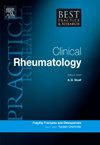系统性红斑狼疮和糖皮质激素:一个永无止境的故事?
IF 4.5
2区 医学
Q1 RHEUMATOLOGY
Best Practice & Research in Clinical Rheumatology
Pub Date : 2023-12-01
DOI:10.1016/j.berh.2023.101873
引用次数: 0
摘要
糖皮质激素(GCs)仍然是治疗系统性红斑狼疮的必要药物,因为没有其他药物能够如此迅速地缓解活动性疾病。然而,它们可能造成不可逆转的损害,这极大地限制了它们的使用。幸运的是,一些策略可能有助于利用其巨大的抗炎能力,同时限制gc引起的副作用。本文综述了GC作用的药理学基础及其在临床中的应用。我们还提供了在诱导和维持治疗中使用GC的实用方法以及作者各自实践的GC退出策略。三个主要的基本原则是a)使用甲基强的松龙脉冲诱导缓解,不仅在严重的疾病;B)将泼尼松的初始剂量限制在≤30mg /d,并迅速逐渐减少到≤5mg /d,这应该是维持治疗的剂量;(3)对撤资决策和策略进行个性化。长期使用HCQ治疗和早期引入免疫抑制治疗将有助于实现这些目标。本文章由计算机程序翻译,如有差异,请以英文原文为准。
Systemic lupus erythematosus and glucocorticoids: A never-ending story?
Glucocorticoids (GCs) continue to be essential agents for the management of systemic lupus erythematosus, since there are no other drugs able to active remission of active disease so rapidly. However, their potential for causing irreversible damage greatly limit their use. Fortunately, some strategies may help take advantage of their huge anti-inflammatory power while limiting GC-induced side effects. This article reviews the pharmacological basis of GC action and their translation into the clinical ground. We also offer the practical approach for the use of GC in induction and maintenance therapy as well as the strategies for GC withdrawal of the respective practice of the authors. The three main basic principles are a) using methyl-prednisolone pulses to induce remission not only in severe disease; b) limiting initial doses of prednisone to ≤30 mg/d, with rapid tapering to ≤5 mg/d, which should be the dose for maintenance therapy; and c) individualizing the decision and the strategy to withdraw GCs. Long-term therapy with HCQ and the early introduction of immunosuppressive treatment would help achieve these objectives.
求助全文
通过发布文献求助,成功后即可免费获取论文全文。
去求助
来源期刊
CiteScore
9.40
自引率
0.00%
发文量
43
审稿时长
27 days
期刊介绍:
Evidence-based updates of best clinical practice across the spectrum of musculoskeletal conditions.
Best Practice & Research: Clinical Rheumatology keeps the clinician or trainee informed of the latest developments and current recommended practice in the rapidly advancing fields of musculoskeletal conditions and science.
The series provides a continuous update of current clinical practice. It is a topical serial publication that covers the spectrum of musculoskeletal conditions in a 4-year cycle. Each topic-based issue contains around 200 pages of practical, evidence-based review articles, which integrate the results from the latest original research with current clinical practice and thinking to provide a continuous update.
Each issue follows a problem-orientated approach that focuses on the key questions to be addressed, clearly defining what is known and not known. The review articles seek to address the clinical issues of diagnosis, treatment and patient management. Management is described in practical terms so that it can be applied to the individual patient. The serial is aimed at the physician in both practice and training.

 求助内容:
求助内容: 应助结果提醒方式:
应助结果提醒方式:


